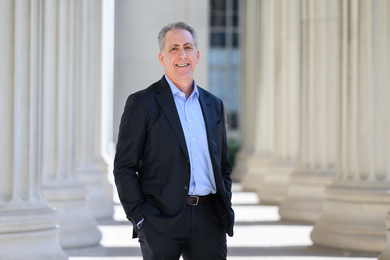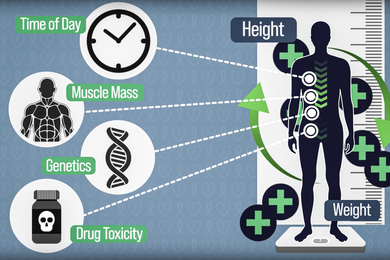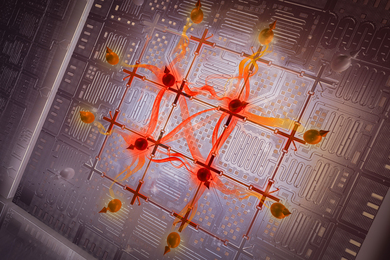Three newly renovated classrooms are making it possible for faculty to teach classic courses in modern ways, using high-tech communications equipment, desktop experiments and even innovative seating arrangements to encourage students--both here and abroad--to take more active roles in the learning process.
Faculty-initiated curriculum revisions in physics and mechanical engineering, as well as the long-distance educational needs of the Singapore-MIT Alliance (see accompanying story), prompted the classroom renovations.
"We are very excited to see these new facilities come online. Educational technology is not an end in itself, but it can be a very important tool in allowing interactions between teachers and students and in allowing active engagement by students in the learning process," said Robert Redwine, dean for undergraduate education and professor of physics.
"It is not often that we inaugurate such technically advanced and pedagogically innovative classrooms to support our educational mission," said Dean of Engineering Thomas Magnanti, who has been supportive of these projects as dean and as co-director of iCampus, the MIT-Microsoft alliance, one of the funders of the renovations. "These classrooms not only permit us to teach and learn in exciting new ways, but they also buoy our spirits and fuel our imagination."
Funding from B.J. (S.M. 1961, M.E. 1963) and Chunghi Park, the Singapore-MIT Alliance and the Institute was used to transform a large flat classroom (Room 3-370) into an amphitheatre-style room with fixed tables and loose chairs to encourage group work; two video projectors; a document camera, VCR, DVD/CD player and Athena workstation; microphones for each student; two flat-screen monitors and four cameras for use during distance education classes.
Now called the B.J. Park and Chunghi Park Room for Innovative Education, the 1,600-square-foot lecture hall is being used to connect teachers and students on campus with their counterparts in Singapore during classes conducted by the Singapore-MIT Alliance (see story on this page). The room also is being used for mechanical engineering educational initiatives funded by a two-year grant from iCampus and run by Professor Mary Boyce, who is using a group-learning format to teach "Mechanics and Materials I: Introduction to Statics and Deformable Solids" (2.001).
Another classroom, Room 3-270 (now called the B.J. Park and Chunghi Park Lecture Hall), also was renovated over the summer into a tiered room seating 119 students in fixed-tablet armchairs. The Level IV lecture hall, a term referring to the level of high-technology equipment installed in the room, doesn't have the distance-education technology that Level V rooms have, but it does have the video projectors, VCR and DVD/CD player. Two Level V rooms (3-370 and 1-390) are now available for general Institute use through the Registrar's Office.
Both 3-270 and 3-370 are easy on the eyes, with plenty of natural light--which can be modulated easily with the motorized sunscreens or blocked entirely with the blackout shades--cherry wood trim and gray carpeting. Technology in the rooms is controlled from a computer at the faculty workstation in the front. The entire project cost $3.4 million, including the data infrastructure and equipment for distance education, the custom tables and other furniture, and the cost of general renovations to both rooms.
PHYSICS EXPERIMENTS
The new studio-style classroom, known as the TEAL classroom, is being used by Professor John Belcher and other physics faculty members to transform the introductory physics courses at MIT.
The Institute funded renovation of the room (26-152), including data infrastructure and furniture for $1.5 million. Money for the Technology Enabled Active Learning Project (TEAL), including projection equipment, laptop computers and redesign of the second-semester introductory physics course (8.02) came from the d'Arbeloff Fund, iCampus and the School of Science. The studio-version prototype of the course adds hands-on experiments and faculty/student interaction to the previously a lecture course (see related story).
"This is one of the most wonderful things the physics department has done in a long time for freshmen," said Professor Marc Kastner, head of the physics department. "The human interactions are what make a place like MIT so special--personal interaction with faculty rather than sitting passively in large lecture halls, which is what they do now in 99 percent of courses at MIT."
The 3,000-square-foot TEAL classroom contains an instructor's workstation in the center of the room, surrounded by 13 round, seven-foot tables seating nine students apiece. The course supplies a networked laptop computer for every three students. The room's periphery is dotted with 13 whiteboards and eight video projectors and screens.
"The idea of that space is that the faculty member not lecture from a fixed location, but walk around with a wireless microphone talking to students about their work," said Peter Bedrosian, assistant to the registrar for classroom management. "The joy of the space is that each table has a whiteboard dedicated to it and a ceiling-mounted camera pointed to that whiteboard, which can be projected onto video screens around the room."
Right now it's being used mainly for the "prototype" version of TEAL/Studio Physics, said Belcher, a Class of 1960 Faculty Fellow who is working with a handful of other physics faculty and staff to teach "Electromagnetism I" (8.02) inclusive of laboratory experiments. Students are exposed to a mix of instruction, lab work with desktop experiments and small-group work.
"We're developing a prototype for a reform of physics education that is designed to help students develop much better intuition about physical phenomena," said Belcher. "The reform is centered on an active-learning approach in a highly collaborative, hands-on environment with extensive use of desktop experiments and educational technology."
Faculty from other courses also are using the TEAL classroom, including Professor Kip Hodges of earth, atmospheric and planetary sciences whose class in "Solving Complex Problems" (12.000) meets there. Freshmen in this course work as teams to develop effective approaches to complex problems in science and engineering that do not have straightforward solutions. This year, they're designing underwater research laboratories and developing detailed research plans for the first six months of operation. The TEAL classroom provides the space and technology the student teams need to accomplish their goals.
A version of this article appeared in MIT Tech Talk on December 12, 2001.







